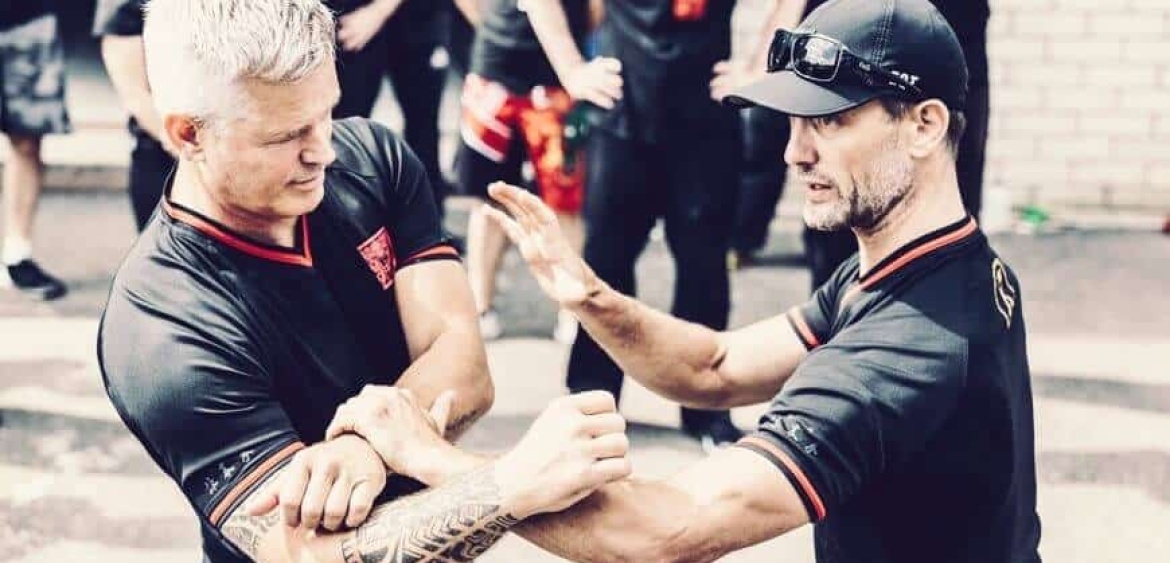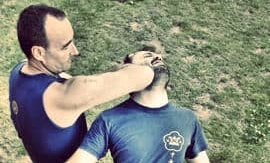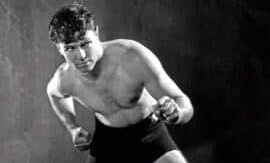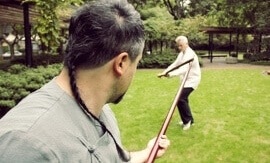
SIFU MARTIN BROGAARD HAS TRAINED MARTIAL ARTS SINCE 1982. BESIDES WING CHUN, HE HAS EXPERIENCE WITH CATCH WRESTLING, JIU-JITSU, SHAOLIN GUNG FU, ESCRIMA, WESTERN BOXING AND MUAY THAI. SINCE 1993, HE HAS PRIMARILY TRAINED WING CHUN AND IS THE FIRST OFFICIAL INSTRUCTOR OF PRACTICAL WING CHUN IN SCANDINAVIA.
Today, Sifu Martin travels the world to spread this amazing art and to honour his Sifu, Grandmaster Wan Kam Leung, and the beautiful culture of Chinese Gung Fu.
Why did you choose Practical Wing Chun?
In 2007, after 14 years of intensive Wing Chun training, I travelled around China with Sifu Pui Yee, one of my good friends and training partners, to find the greatest master alive. On the journey, we trained with and interviewed a wide range of recognised masters of Wing Chun. One of those was Grandmaster Wan Kam Leung, who clearly stood out from all the other masters. Touching hands with him was like nothing I ever experienced. It felt like Grandmaster Wan had superpowers, constantly controlling me and always being one step ahead. On top of this, his theoretical explanations were so enlightening and logical that we had no doubt—we had found our master! Since 2007, I’ve been travelling to Hong Kong several times every year to train privately with him, who just gets better and better with time.
How do you see the Wing Chun system?
Wing Chun is an intelligent, no-rules fighting system, made for real-life physical conflict management on any level. Wing Chun is a conceptual system that’s built on principles and often taught with sayings as guidelines, explaining strategies, tactics, and methods using short sentences, which can be interpreted and applied with techniques later memorised and integrated into forms, where they are strung together. They are trained in different applications until they have become a natural way of using the body.
What do you think makes Wing Chun unique as a martial art?
What makes Wing Chun unique is the fundamental principle of only using technical skills that can overcome an opponent’s superior power, weight, speed, and reach. This paradigm lies behind the legend of Wing Chun being originated by a woman. It’s a combination of the way Wing Chun uses body mechanics and the basic strategy of always having a technical advantage.
What do you consider the fundamental principles of Wing Chun?
There are many fundamental principles in Wing Chun, but as a foundation, the most important ones are these five elements:
Control. It’s about controlling the “battlefield.” The Wing Chun practitioner does that by catching and keeping the striking distance. Controlling or trapping the opponent’s arms, redirecting the opponent’s attacks, and manipulating their balance and position, while constantly attacking vulnerable targets with effective attacks.
Efficiency. It’s about being fast, not just with high speed, but also by using optimal economy of motion. We relate economy of motion to short and direct movements, simultaneously in attack and defence and using the whole body as a tool for attacking and defending.
Effectiveness. The shorter the fight, the less likely you get hurt. Therefore, all attacks must be powerful, aimed at vulnerable targets, and ideally done continuously until the fight is over.
Balancing Soft and Hard Power. Maintain a stable structure, as the saying goes: “You can’t fire a cannon from a canoe.” Take an advantageous position and manipulate the opponent’s balance and position. Be soft and adaptable if the opponent uses force and use it against them. It’s about attacking the weak points and avoiding the strong ones.
Internal Energy (Qi). Using Qi in fighting is the Internal part of Gung Fu. It’s something I believe all true masters have developed. External Gung Fu is the system’s fighting strategies, tactics, methods, and techniques. Internal Gung Fu is mastery of Internal Energy. It’s cultivated through Internal Awareness and sensing the energy through your balance, posture and base of support (rooting). It’s about attached and unattached breathing, controlled movement and stillness, specific tension and relaxation, including delivery, absorption, and redirection of force. This has to be done with accuracy in movement and coordination, fluidity and adaptability, from static through different tempo to explosiveness. It can be cultivated through your Wing Chun training, but it can also be trained separately through Qigong (“Energy Work”) and afterwards integrated into your system with great benefits.
What is so unique about Practical Wing Chun?
It’s the way we interpret Wing Chun principles relative to physical laws and the way we constantly focus on seeking an advantage and striving for an ideal way to achieve this. In Practical Wing Chun, techniques and forms will evolve through time, but the concepts and principles are universal, leaving a trail to follow. As long as you follow this trail, there’s no right or wrong, just more or less ideal. All our techniques are related to body mechanics, e.g., body planes and axis, levers, angles, lines, rotations, and circles as generators of force.
What do you consider the weakness of Wing Chun?
Since Wing Chun is a principle-based system, I don’t think it has any weakness. Maybe the forms do not include ground fighting, but that’s not a lack in the system, but a restriction on the application according to tradition. The same goes for fighting against a gun or any other modern weapon. The weakness is in the way it often is watered down and the way it’s interpreted, trained and applied. A lot of practitioners see Wing Chun as a collection of universal applicable techniques, but techniques will evolve through time, like in any other skill, and is not universal. Techniques are just methods to work with energy based on strategy and tactics.
If you want to be complete as a Wing Chun practitioner, work on understanding and develop your ability. Deeper understanding comes from seeking knowledge from your Sifu, sharing it, testing it, and reflecting on it.
I also believe your training should include the following elements:
• Mindful forms, including equipment, e.g. the Wooden Dummy.
• Wing Chun shadow fighting, including all the footwork.
• Target practice, including, e.g. wall-bags, punching bags, focus mitts.
• Partner exercises, e.g. San Sau, Chi Sau, Gor Sau.
• Hard and Soft Qigong.
• Weapons training.
• Multiple opponents.
• Functional physical training.
What is your interest outside of martial arts?
Since 1994, I have studied and taught sports performance coaching, teaching methodology, and biomechanics. I also have a great interest in philosophy and psychology, and this knowledge benefits me as a trainer in martial arts.
Do you have a vision for your Wing Chun?
My personal goals are to develop the Practical Wing Chun system further, showing the world its greatness, sharing these many treasures, and making it all accessible to anyone with the right mindset. Soon, I believe we will succeed in integrating principles from Wing Chun into all kinds of martial arts and possibly to bring it into different institutions that work with the management of physical conflict. I also like to help others to see the beauty of Wing Chun and help to integrate it into the Hollywood movie productions on a larger scale. I believe we will see a future, where lots of people apply Wing Chun principles as strategies in all parts of life with great benefit.



















